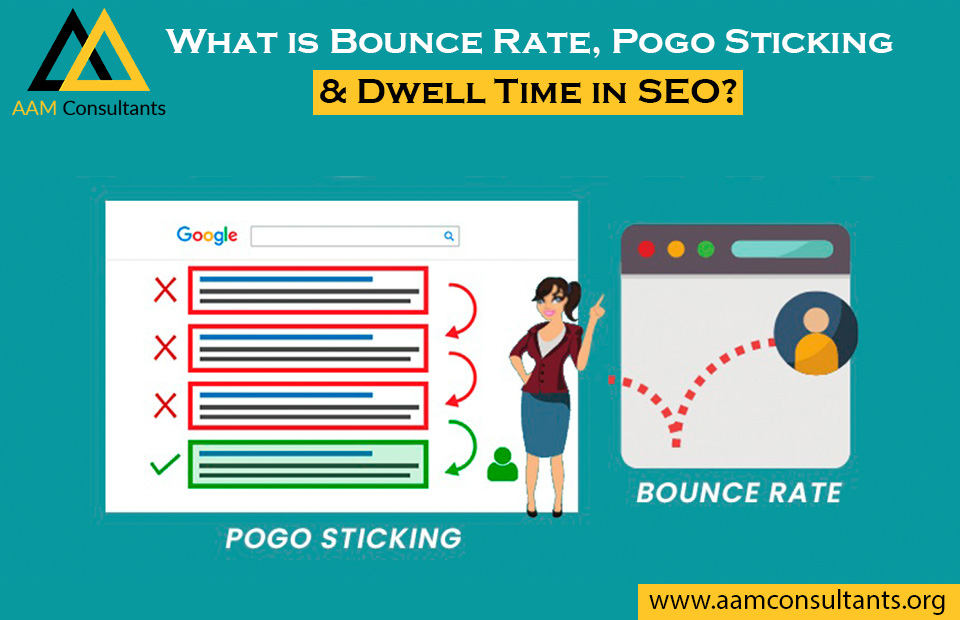With over four billion internet users in the world today, there is a lot of data to be explored with regards to peoples’ behavior when searching online. As a business owner, it’s important to heighten your awareness when it comes to internet searches, specifically bounce rate, pogo sticking and dwell time in SEO. Here you’ll discover the difference between these three common types of internet behaviors and how you can optimize your website to improve user experience.
Hire AAM Consultants for link building and SEO Services.
What is Pogo Sticking?
When a searcher hops from one search result to the next without spending a lot of time on one particular page, this would be described as pogo sticking. For example, a user may type a query into the search bar, then proceed to click on link after link on the results page without spending more than five seconds on each page. Returning to the results page on the Google search engine over and over again usually indicates that the user hasn’t found exactly what they’re looking for.
What is Bounce Rate?
The volume of traffic or number of users that navigate back to the search results via the back button on the browser without making a purchase is the bounce rate of a website. In essence, they are moving back from the webpage without exploring any of the internal hyperlinks or taking any form of action.
The Difference Between Pogo Sticking and Bounce Rate
You may be wondering what the difference is between pogo sticking and bounce rate, as they are both similar concepts in theory. Ultimately, pogo sticking occurs when a user is dissatisfied with the page content and spends no longer than five seconds on a page. With regards to bounce rate, a user could spend several hours on a page but still take no action; it is often unclear whether they are or aren’t satisfied with the page content.
In order to dive deeper into bounce rate and pogo sticking, it’s important to explore the notion of dwell time and how this can be measured.
What is Dwell Time?
In short, dwell time is the amount of time a particular user spends on a web page. Bounce rate could be both a very low dwell time and a very high dwell time; pogo sticking is always an extremely low dwell time. It’s clear that pogo-sticking is not a good sign for any website, however, bounce rate is extremely important to analyze for a number of reasons. Let’s explore why bounce rate is a fundamental piece of data for every online business and how to improve it.
Why is Bounce Rate Important?
Bounce rate can indicate whether the content on your website or blog is informative, engaging, relevant, and interesting to your target audience. For example, if a user searches how to carve a pumpkin and spends five minutes reading a five-hundred-word article, it could be classed as a bounce, but it’s not necessarily a bad thing. It’s likely that the user got all of the information they needed from the article and they found your content extremely useful. Google would recognize that this was a natural bounce off the page, as the user stayed for a while and absorbed the content they needed.
How Do Bounce Rate, Pogo Sticking, and Dwell Time Correlate?
When the dwell time corresponds positively with the number of words on the page and the scroll depth, this is a good indicator that will be signalled to Google. On the other hand, if the dwell time is very low it’s a clear sign of a bad user experience; If a high number of searchers or hitting the back button straight away, this will send a negative indicator to Google as pogo-sticking is occurring.
What’s a Good Bounce Rate and How Do You Calculate It?
Generally speaking, a brilliant bounce rate ranges between 25 to 40 percent, and an average bounce rate is between 41 to 55 percent. You can undertake a bounce rate analysis on your website by using the following formula:
Divide the total number of one-page visits by the total number of entries onto a website.
For example, if fifty searchers leave the website without being absorbed into further interactions, and there have been one hundred visitors overall, the bounce rate will be 50%.
How Can You Reduce Bounce Rate?
Clearly, it’s important to analyze your bounce rate and put measures into place to reduce it as much as possible. You can reduce the bounce rate of your website by implementing some of the following ideas:
- Improve the readability of your content by using subheadings and shorter paragraphs
- Write an enticing call to actions and let your reader know where to click next
- Learn the art of storytelling to create engaging content for your audience
- Include images, infographics, and other visuals to break up the content on the page
- Make the most of internal links and popular articles
With all of this in mind, you should be able to improve the bounce rate on your website and increase dwell time, so that Google recognizes you’re a credible and reliable source for your target audience!




